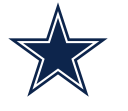
| Dallas Cowboys | |||
| Current season | |||
|
Established 1960; 53 years ago Play in Cowboys Stadium Arlington, Texas Headquartered in Valley Ranch Irving, Texas |
|||
|
|||
| League/conference affiliations | |||
|
National Football League (1960–present) Western Conference (1960) Eastern Conference (1961–1969) Capitol Division (1967–1969) National Football Conference (1970–present) NFC East (1970–present) |
|||
| Current uniform | |||
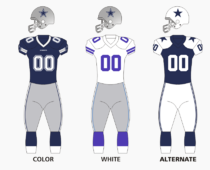 |
|||
| Team colors |
Royal Blue, Silver, Metallic Silver Blue, Navy, and White |
||
| Mascot | Rowdy | ||
| Personnel | |||
| Owner(s) | Jerry Jones | ||
| President | Jerry Jones | ||
| General manager | Jerry Jones | ||
| Head coach | Jason Garrett | ||
| Team history | |||
| Dallas Cowboys (1960–present) | |||
| Team nicknames | |||
|
America's Team Doomsday Defense The Boys Big D |
|||
| Championships | |||
|
League championships (5) Super Bowl Championships (5) 1971 (VI), 1977 (XII), 1992 (XXVII), 1993(XXVIII), 1995 (XXX) |
|||
|
Conference championships (10) NFL Eastern: 1966, 1967 NFC: 1970, 1971, 1975, 1977, 1978, 1992, 1993, 1995 |
|||
|
Division championships (21) NFL Capitol: 1967, 1968, 1969 NFC East: 1970, 1971, 1972, 1973, 1976, 1977, 1978, 1979, 1981, 1985, 1992, 1993, 1994, 1995, 1996, 1998, 2007, 2009 |
|||
| Playoff appearances (30) | |||
| NFL: 1966, 1967, 1968, 1969, 1970, 1971, 1972, 1973, 1975, 1976, 1977, 1978, 1979, 1980, 1981, 1982, 1983, 1985, 1991, 1992, 1993, 1994, 1995, 1996, 1998, 1999, 2003, 2006, 2007, 2009 | |||
| Home fields | |||
|
Cotton Bowl (1960–1971) Texas Stadium (1971–2008) Cowboys Stadium (2009–present) |
|||
The Dallas Cowboys are a professional American football franchise that plays in the Eastern Division of the National Football Conference (NFC) of the National Football League (NFL). They are headquartered in Valley Ranch in Irving, Texas, a suburb of Dallas. The team plays its home games at Cowboys Stadium in Arlington, Texas, within the Dallas–Fort Worth metropolitan area, which finished construction in time for the 2009 season.[1] The Cowboys joined the NFL as a 1960 expansion team.[2] The team's national following might best be represented by its NFL record of consecutive home sell-outs. The Cowboys' streak of 160 sold-out regular and post-season games began in 1990, and included 79 straight sellouts at their former home, Texas Stadium, and 81 straight sell-outs on the road.[3] The franchise shares the record for most Super Bowl appearances (8) with the Pittsburgh Steelers, corresponding to most NFC championships (8).[4] The Cowboys are the only NFL team to record 20 straight winning seasons (1966–85), in which they only missed the playoffs twice (1974 and 1984), an NFL record that remains unchallenged.
An article from Forbes Magazine, dated September 5, 2012, lists the Cowboys as the highest valued sports franchise in the history of the United States, and second in the world (behind Manchester United of the English Premier League), with an estimated value of approximately $2.1 billion.[5] They are also the wealthiest team in the NFL, generating almost $269 million in annual revenue.[6]
History
Main article: History of the Dallas Cowboys
1960s
Prior to the formation of the Dallas Cowboys, there had not been an NFL team south of Washington DC since the Dallas Texans folded in 1952. Oilman Clint Murchison Jr had been trying to get an NFL expansion team in Dallas (also Lamar Hunt – who ended up with an AFL franchise), but George Preston Marshall owner of the Washington Redskins had a monopoly in the south.
Murchison had tried to purchase the Washington Redskins from Marshall in 1958. An agreement was struck, but as the deal was about to be finalized, Marshall called for a change in terms. This infuriated Murchison and he called off the deal. Marshall then opposed any franchise for Murchison in Dallas. Since NFL expansion needed unanimous approval from team owners at that time, Marshall's position would prevent Murchison from joining the league.
Marshall had a falling out with the Redskins band leader BarneeBreeskin. Breeskin had written the music to the Redskins fight song "Hail to the Redskins" and Marshall’s wife had penned the lyrics. Breeskin owned the rights to the song and was aware of Murchison’s plight to get an NFL franchise. Angry with Marshall, Breeskin approached Murchison’s attorney to sell him the rights to the song before the expansion vote in 1959. Murchison purchased "Hail to the Redskins" for $2,500. Before the vote to award franchises in 1959, Murchison revealed to Marshall that he owned the song and Marshall could not play it during games. After a few Marshall expletives, Murchison gave the rights to "Hail to the Redskins" to Marshall for his vote, the lone one against Murchison getting a franchise at that time, and a rivalry was born.
1980s and 1990s
Danny White became the Cowboys' starting quarterback in 1980 after quarterback Roger Staubach retired. White led the Cowboys to the playoffs five times and won two Division Championships. However, despite playing in the NFC Championship Game three consecutive years (1980–1982), the Cowboys did not reach the Super Bowl during the 1980s. In 1984, H.R. "Bum" Bright purchased the Dallas Cowboys from Clint Murchison, Jr. As the Cowboys suffered through progressively poorer seasons (from 10–6 in 1985 to 7–9 in 1986, 7–8 in 1987, and 3–13 in 1988), Bright became disenchanted with the team. During the Savings and Loan crisis, the team and Mr. Bright's Savings and Loan were taken over by the FSLIC. During an embarrassing home loss to Atlanta in 1987, Bright told the media that he was "horrified" at coach Tom Landry's play calling. The FSLIC forced Mr. Bright to sell the Cowboys to Jerry Jones on February 25, 1989.
Jones immediately fired Tom Landry, the only head coach in franchise history, replacing him with University of Miami head coach Jimmy Johnson. With the first pick in the draft, the Cowboys selected UCLA quarterback Troy Aikman. Later that same year, they would trade veteran running back Herschel Walker to the Minnesota Vikings for five veteran players and eight draft choices. Although the Cowboys finished the 1989 season with a 1–15 record, their worst in almost 30 years, "The Trade" later allowed Dallas to draft a number of impact players to rebuild the team.
Johnson quickly returned the Cowboys to the NFL's elite. Skillful drafts added fullback Daryl Johnston and center Mark Stepnoski in 1989, running back Emmitt Smith in 1990, defensive tackleRussell Maryland and offensive tackle Erik Williams in 1991, and safety Darren Woodson in 1992. The young talent joined holdovers from the Landry era such as wide receiver Michael Irvin, guardNate Newton, linebacker Ken Norton Jr., and offensive lineman Mark Tuinei, defensive lineman Jim Jeffcoat, and veteran pickups such as tight end Jay Novacek and defensive end Charles Haley.
The Cowboys improved to 7-9 in 1990. In 1991 the Cowboys replaced offensive coordinator Dave Shula with Norv Turner; the Cowboys raced to a 6-5 start then defeated the previously-unbeatenRedskins despite injury to Troy Aikman. Backup Steve Beuerlein took over and the Cowboys and finished 11-5, then defeated the Bears for the Cowboys' first playoff win since 1982. The season ended in a 38-6 playoff rout by the Lions.
In 1992 Dallas set a team record for regular season wins with a 13–3 mark. In January 1993, only three years after their 1–15 season, the Cowboys earned their first Super Bowl trip in 14 seasons. Dallas defeated the Buffalo Bills 52–17 in Super Bowl XXVII, during which they forced a record nine turnovers. Johnson became the first coach to claim a national championship in college football and a Super Bowl victory in professional football. The following season, they again defeated the Buffalo Bills in Super Bowl XXVIII, 30–13. The Cowboys sent a then-NFL record 11 players to the Pro Bowl in 1993: Troy Aikman, safety Thomas Everett, Irvin, Johnston, Maryland, Newton, Norton, Novacek, Smith, Stepnoski and Williams.
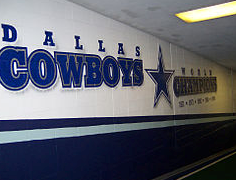
Five-time World Champions Mural
Only weeks after Super Bowl XXVIII, however, friction between Johnson and Jones culminated in Johnson stunning the football world by announcing his resignation. Jones then hired former University of Oklahoma head coach Barry Switzer to replace Johnson. The Cowboys finished 12–4 in 1994, but missed the Super Bowl by losing to the San Francisco 49ers in the NFC Championship Game, 38–28. In 1995, Jones lured All-Pro cornerback Deion Sanders away from San Francisco, and Dallas once again posted a 12–4 regular season record. The Cowboys defeated the Pittsburgh Steelers 27–17 at Sun Devil Stadium in Super Bowl XXX for their fifth world championship. Switzer joined Johnson as the only coaches to win a college football national championship and a Super Bowl.
Yet the glory days of the Cowboys were again beginning to dim as free agency, age and injuries began taking their toll. Star receiver Michael Irvin was suspended by the league for the first five games of 1996 following a drug-related arrest; he came back after the Cowboys started the season 2-3; they finished 10-6 and won the NFC East title, but were eliminated in the divisional round of the playoffs 26-17 by the second-year Carolina Panthers. The Cowboys went 6–10 in 1997, with discipline and off-field problems becoming major distractions. As a result, Switzer resigned as head coach in January 1998 and former Steelers offensive coordinator Chan Gailey was hired to take his place. Gailey led the team to two playoff appearances with a 10–6 record in 1998 and an NFC East championship, but the Cowboys were defeated in the playoffs by the Arizona Cardinals 20-7; after an 8–8 season in 1999 (during which Irvin suffered a career-ending spinal injury in a loss to the Philadelphia Eagles) ending in another playoff loss (this time to the Minnesota Vikings 27-10), he was fired and became the first Cowboys coach who did not take the team to a Super Bowl.
2000 – present
Defensive coordinator Dave Campo was promoted to head coach, but he could only post three consecutive 5–11 seasons. Many fans and media were beginning to blame Jerry Jones for the team's ills, noting that he refused to hire a strong coach or general manager, preferring to hire coaches who did not want to be involved with personnel duties so that Jones himself, as GM, could manage them. Jones then lured Bill Parcells out of retirement to coach the Cowboys. The Cowboys became the surprise team of the 2003 season, posting a 10–6 record and a playoff berth by having the best overall defense in the NFL. The Cowboys then finished an up-and-down 2006 season with a 9–7 record and a playoff appearance, but after a last second loss in the wild-card game against the Seattle Seahawks, Parcells retired and was succeeded by Wade Phillips.[7] In his first season as head coach, Phillips and his coaching staff led the franchise to its best seasonal start ever, a conference-best 13–3 record, and the franchise's 16th NFC East championship title, the most of any team in that division.[8] The Cowboys were eliminated by the (eventual Super Bowl Champion) Giants in the divisional round of the playoffs, the first NFC No. 1 seed to do so since the 1990 playoff re-alignment.
In the tumultuous 2008 season, the Cowboys started off strong, going 3–0 for the second straight year, en route to a 4–1 start. However, things soon went downhill from there, as quarterback Tony Romo suffered a broken pinkie in an overtime loss to the Arizona Cardinals. With Brad Johnson and Brooks Bollinger playing as backups, Dallas went 1–2 during a three-game stretch. Romo's return showed promise, as Dallas went 3–0. However, injuries mounted during the season with the team losing several starters for the year, such as Kyle Kosier, Felix Jones, safety Roy Williams and punter Mat McBriar, and several other starters playing with injuries.[9] Entering December, the 8–4 Cowboys underperformed, finishing 1–3. They failed to make the playoffs after losing at Philadelphia in the final regular season game which saw the Eagles reach the playoffs instead.
On May 2, 2009, the Dallas Cowboys' practice facility collapsed during a wind storm. The collapse left twelve Cowboys players and coaches injured. The most serious injuries were special teams coach Joe DeCamillis, who suffered fractured cervical vertebrae and had surgery to stabilize fractured vertebrae in his neck, and Rich Behm, the team's 33-year-old scouting assistant, who was permanently paralyzed from the waist down after his spine was severed.
The 2009 season started on a positive with a road win against Tampa Bay, but fortunes quickly changed as Dallas fell to a 2–2 start. In week five, with starting wide receiver Roy Williams sidelined by injury, receiver Miles Austin got his first start of the season and had a record setting day (250 yards receiving and 2 TDs) to help lead Dallas to an overtime win over Kansas City. Following their bye week, Dallas went on a three game winning streak including wins over Atlanta and NFC East division rival Philadelphia. Despite entering December with a record of 8–3, Dallas lost its slim grip on 1st place in the division with losses to the New York Giants and San Diego. Talks of past December collapses resurfaced, and another collapse in 2009 seemed validated. However, the Dallas team surged in the final three weeks of the season with a 24–17 victory at the Superdome, ending New Orleans' previously unbeaten season in week 15. For the first time in franchise history, Dallas posted back-to-back shutouts when they beat division rivals Washington (17–0) and Philadelphia (24–0) to end the season. In the process, the Cowboys clinched their second NFC East title in three years as well as the third seed in the NFC Playoffs. Six days later, in the wild-card round of the playoffs, Dallas played the Eagles in a rematch of week 17. The Cowboys defeated the Eagles for the first Cowboys' post-season win since the 1996 season, ending a streak of six consecutive NFL post-season losses. Dallas ended their playoff run after a hard divisional playoff loss to the Minnesota Vikings.
After beginning the 2010 season at 1–7, Phillips was fired as head coach and was replaced by offensive coordinator Jason Garrett as the interim head coach.[10] The Cowboys finished the season 6–10.
2011
Main article: 2011 Dallas Cowboys season
With the 9th pick of the 1st round of the 2011 draft, the Cowboys selected USC tackle Tyron Smith.
The Cowboys played the New York Jets on a Sunday night primetime game in New York, on September 11, 2011. The Cowboys held the lead through most of the game, until a fumble, blocked punt, and interception led to the Jets coming back to win the game. In week 2 Dallas traveled to San Francisco to play the 49ers. In the middle of the 2nd quarter, while the Cowboys trailed 10-7, Tony Romo suffered a rib injury and was replaced by Jon Kitna. Kitna threw 1 Touchdown and 2 interceptions until Romo returned in the 3rd quarter as Dallas trailed 17-7. Romo then threw 3 touchdown passes to Miles Austin as the Cowboys rallied to send the game into overtime. On the Cowboys opening possession after 49ers punt, Romo found WR Jesse Holley on a 78 yard pass, which set up the game winning field goal by rookie kicker Dan Bailey.
2012
Main article: 2012 Dallas Cowboys season
Logos and uniforms
Logo

The script logo.
The Dallas Cowboys' blue star logo representative of Texas as "The Lone Star State" is one of the best known team logos in professional sports. The blue star originally was a solid shape until a white line and blue border was added in 1964. The logo has remained the same since. Today, the blue star has been extended to not only the Dallas Cowboys, but owner Jerry Jones' AFL team, the Dallas Desperados that have a similar logo based on the Cowboys. The blue star also is used on other entries like an imaging facility and storage facility.
Uniforms
The Dallas Cowboys' white home jersey has royal blue (PMS 280 C) solid socks, numbers, lettering, and two stripes on the sleeves outlined in black. The home pants, according to the Dallas Cowboys official media guide, are a common metallic silver-blue color (PMS 8280 C) that help bring out the blue in the uniform. The navy (PMS 289 C) road jerseys (nicknamed the "Stars and Stripes" jersey) have white lettering and numbers with navy pinstripes. A white/gray/white stripe are on each sleeve as well as the collared V-neck, and a Cowboys star logo is placed upon the stripes. A "Cowboys" chest crest is directly under the NFL shield. The away pants are a pearlish metallic-silver color (PMS 8001 C) and like the home pants, enhance the navy in the uniforms. The team uses a serifed font for the lettered player surnames on the jersey nameplates.
•

Dallas Cowboys' current home uniform
• 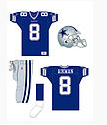
Dallas Cowboys' current away uniform
The team's helmets are also a unique silver with a tint of blue known as "Metallic Silver Blue" (PMS 8240 C) and have a blue/white/blue vertical stripe placed upon the center of the crown. The Cowboys also include a unique, if subtle, feature on the back of the helmet: a blue strip of Dymo tape with the player's name embossed, placed on the white portion of the stripe at the back of the helmet.
•

Front of Dallas Cowboys helmet
•
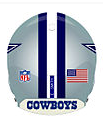
Back of Dallas Cowboys helmet
Uniform history
When the Dallas Cowboys franchise debuted in 1960, the team's uniform included a white helmet adorned with a simple blue star and a blue-white-blue stripe down the center crown. The team donned blue jerseys with white sleeves and a small blue star on each shoulder for home games and the negative opposite for away games. Their socks also had two horizontal white stripes overlapping the blue.
•
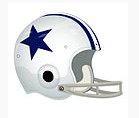
c1960–1963
•
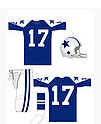
Blue home uniforms
•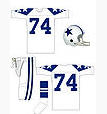
White away uniforms
In 1964 the Cowboys opted for a simpler look (adopting essentially the team's current uniform) by changing their jersey/socks to one solid color with three horizontal stripes on the sleeves; the white jersey featured royal blue stripes with a narrow black border, the royal blue jersey white stripes with the same black outline. The star-shouldered jerseys were eliminated; "TV" numbers appeared just above the jersey stripes. The new helmet was silverblue, with a blue-white-blue tri-stripe down the center (the middle white stripe was thicker). The blue "lone star" logo was retained, but with a white border setting it off from the silverblue. The new pants were silverblue, with a blue-white-blue tri-stripe. In 1964 the NFL allowed teams to wear white jerseys at home; several teams did so, and the Cowboys have worn white at home ever since, except on certain "throwback" days.


